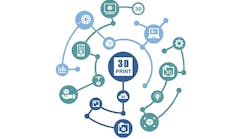One of the more apparent ways that 3-D printing technology could be used to transform the supply chains is by reducing manufacturing lot sizes. This would enable smaller—even discrete—manufacturing runs, according to Adam Kidd and Jamie Sciacchitano, consultants with GRA.
This improved method of more closely matching supply with demand would be especially useful for companies that have low volumes and the levels of manufacturing complexity is low to moderate. For example, medical devices would be applicable as there are a variety of customized, low-volume finished products.
Another way 3-D printing may change supply chains is by challenging the traditional view of the distribution network—specifically, by being used to decentralize manufacturing, the consultants explain. As 3-D printers are able to provide the flexibility required to produce a higher variety of end products than traditional manufacturing lines with less overhead, by developing 3-D printing capability closer to customers, companies may be able to reduce reliance on traditional capital intensive manufacturing lines in centralized locations.
While these are definite advantages, the consultants warn that 3-D printing is not a golden bullet and won’t negate the need for traditional supply chain disciplines, such as demand planning or inventory management, while issues with energy usage and suitable materials also need to be addressed.
Read more on 3-D printing and its effect on the supply chain on IndustryWeek.
IndustryWeek is companion site within Penton’s Manufacturing & Supply Chain Group.



